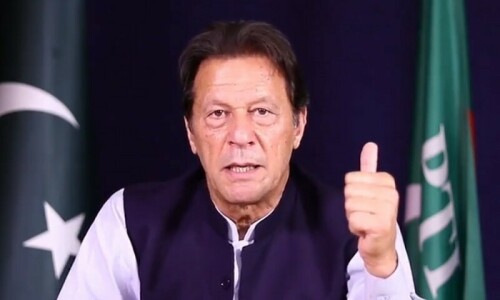KARACHI, Nov 12: The State Bank of Pakistan increased on Wednesday the benchmark interest rate by two percentage points to 15 per cent.
Addressing a news conference, SBP Governor Dr Shamshad Akhtar said: “Given the persisting demand pressures, the State Bank is raising policy rate from 13 per cent to 15 per cent. This will not only help in aligning aggregate demand with supply but also provide room to accommodate government’s financing requirements from commercial banks.”
The decision would also help in calming down sentiments prevailing in the foreign exchange market and in stemming a second-round impact of high inflation from spreading further, she added.
Dr Akhtar said: “It was the most difficult decision of my life,” but it was needed to bring corrections in the macroeconomic imbalances of the economy, despite its painful impact.
According to bankers and business leaders, the interest rate has been raised to meet one of the preconditions of the International Monetary Fund for securing its loan and another 1.5 per cent increase is likely in January.
The SBP governor, however, said the discount rate had been increased to stabilise the economy, strengthen exchange rate and reduce fiscal deficit. She hinted at another increase in future.
She said that Pakistan was not the only country to increase interest rate, but Ukraine, Vietnam and Hungry also had done so recently.
Ukraine and Hungry got the IMF loan after increasing the rate.
Dr Akhtar said Pakistan’s macroeconomic imbalances were different from those of the countries which had reduced their the rates to avoid recession.
The US Federal Reserve reduced interest rate by just one per cent to pump liquidity into the system in order to generate economic growth. Other economies, including India, have also cut interest rate.
Higher interest rate is bound to reduce flow of liquidity into the economy and slow down growth.
The SBP governor said the rate had been increased to reduce external current account deficit supported by appropriate exchange rate policy and to bring fiscal deficit to a sustainable level by rationalising expenditures and strengthening tax revenue generation.
She said that the July-October data had forced the central bank and the ministry of finance to take this decision, otherwise it could be delayed for another month.
Dr Akhtar identified four principal factors -- continued growth in public sector spending beyond resource availability, surge in the July-Oct import bill by 35.2 per cent and depleting reserves and accelerated inflation -- which had been complicating macroeconomic management.
“It is critical to recognise that magnitude, depth and impact of global crisis vary across regions and countries and that domestic macroeconomic situation differs in each country,” she said.
Despite expected deceleration in domestic inflation in the second quarter of 2008-09 due to fall in international commodity prices and impact of monetary tightening measures adopted in May and July, average headline inflation will be around 21 per cent against a target of 11 per cent for whole year.
Dr Akhtar said that due to high inflation and inflationary expectations, current levels of real interest rates had turned out to be negative.
She said that depreciation in the value of the rupee was inevitable and necessary if distortion in economic fundamentals emerged, particularly in external sector imbalances.
“There is a need to arrest depletion in reserves (gross reserves are now close to $6.9 billion, or equivalent to 9 weeks of imports) and restore the confidence of international players and market to build the country’s foreign exchange reserves.”
The governor announced that the central bank would provide 100 per cent financing under Export Finance Scheme-Part II.
She said the SBP had released about Rs270 billion through the lowering of reserve ratios and around Rs10 billion by providing 100 per cent refinancing to banks under EFS-Part I to meet growing working capital financing requirements of exporters.
Dr Akhtar said that the import growth was expected to slow down to 2 per cent (may even turn negative) due to falling commodity prices in the international market and exchange rate-induced domestic demand moderation and external current account deficit had been projected to remain between 6.2 to 6.8 per cent of the GDP.
Effects of continuing strong trends in remittances and an export growth of around 10 per cent would also show their impact, she added.
“Given the uncertainty regarding foreign inflows and the need to build up the country’s foreign exchange reserves to end-June 2008 levels, the ‘financing gap’ is expected to be around $4.5 billion.”














































Dear visitor, the comments section is undergoing an overhaul and will return soon.